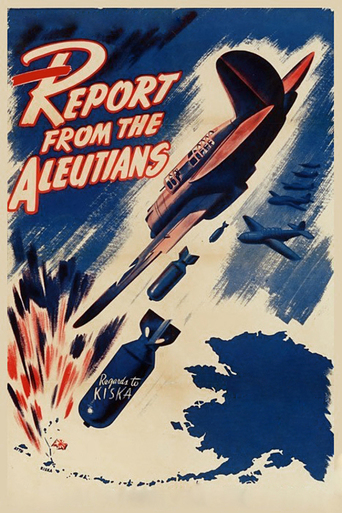Robert J. Maxwell
One of John Huston's contributions to the war effort. His engaging voice narrates the facts of being in the armed forces and stationed on one of the Aleutian Islands, which extend southwestward from Alaska. The narration begins with an unsparing look at the geography of the archipelago -- rough and volcanic, treeless, and a merciless climate.By the time of this release, the Japanese had landed on Kiska, one of the outer islands, and had made a naval feint to distract the US fleet from a defense of Midway. The feint failed. The on-and-off conflict with the Japanese went on for some time, mostly consisting of our bombing their positions whenever the weather allowed. In the end, the US Army landed on the Japanese-held islands only to find they had folded their tents and silently stolen away.The documentary is kind of stuck with a description of humdrum work in a dreary place, leading to an extended salute to the men who run the supplies in and out of Dutch Harbor, the engineers who drive the bulldozers. The men wear old-fashioned campaign hats, carry Springfield rifles with old-fashioned long bayonets, and some wear the broad-brimmed pre-war steel helmets.We see the usual scenes. Mail call is a treasure. The food is awful -- powdered eggs and canned this-and-that. They play old songs on guitars and harmonicas. Everyone attends services by Catholic, Protestant, and Jewish chaplains. No booze, no women. However, the troops are cheerful and morale is high. Nothing can blunt the keenness of these gum-chewing boys in their parkas.There are some finely done shots of airplanes taking off and landing -- P-39s, P-38s, P-40s, B-17s, B-26s, and B-24s. It's startling to see an airplane like the P-38, with its tricycle landing gear, plowing at speed through a foot of water and creating a moving fountain of gray that masks the airplane itself except for its dark nose which juts out ahead of the watery curtain.The film ends with a bombing mission of nine B-17s over Kiska. It's no more alluring than life back in Dutch Harbor although far more dangerous. There are bursts of flak, and though there have been casualties on other missions, this one returns safely.
oscar-35
*Spoiler/plot- 1943, A documentary film of the work and challenges of getting supplies and soldiers to stop the Japanese expansion into the North American continent in the Alaskan Island chain.*Special Stars- Director: John Huston *Theme- Determination and planning will win battles.*Trivia/location/goofs- Color documentary. John Huston almost killed in bombing raid over an island. These island battles were often called: 'The Forgotten Battles'. Actor Charlton Heston was another veteran of these cold island operations.*Emotion- An enjoyable documentary made up of live action combat or newsreel footage. But it is extremely educational and does what a narrative simulated war film can do.
Michael_Elliott
Report from the Aleutians (1943)*** (out of 4) John Huston directed and narrates this Academy Award winning documentary that takes a look at the American troops who went up to protect Alaska during WWII so that it wouldn't be open to attack from the Japanese. Frank Capra, William Wyler, John Ford and many other legendary directors made these documentaries during WWII but of all I've seen (and I've seen most) it was Huston who really delivered something different. He made a handful of these documentaries and they were all quite different from others and I'd say that if you know his reputation then you'd understand why. Huston was always known for being a man's man as he loved to fight, drink, have a good time and live adventure. His documentaries were so different from the others because he seemed to focus in on things that the others wouldn't dare do. Apparently the U.S. government objected to some of the stuff he shot here but the director stood by his guns and these scenes are actually the most entertaining in the movie. These scenes involved showing what the soldiers were doing when not on actual duty. This includes them shaving, cleaning their pots and pans and just wrestling around in front of the camera. It's really these scenes here that give you a great idea of what it was like out in the field and we get to see things that other directors often didn't show. Most of the time it was just about rules, bravery and the actual combat footage but Huston goes an extra mile and gives you a complete idea of the scene. Most of the action comes at the very end as we see some combat missions with the B-17s.
rsoonsa
Director John Huston, while a member of the U.S. Army Signal Corps in 1943, creates an Academy Award winning documentary, which he narrates with assistance from his actor father Walter, treating of the Armed Forces' successful effort to prevent the fall of the Aleutian Islands to advancing Japanese troops who had captured several islets. Although no claim can be reasonably made that this location was of major strategic importance during the War, it presented enormous tactical and logistic difficulty for those assigned there, and Huston's color film demonstrates the determined ensemble work upon the outpost of Adak by a wide range of military specialists who combat loneliness and boredom along with notably severe weather conditions. The work was made over a six month period, and is climaxed by the preparations for, followed by an actual filming of, a bombing run over Japanese-occupied Kiska, wherein Huston nearly lost his life, and which is significant for its combat footage and for the atmosphere of suspense present in the viewer who wonders if all will return safely.



